Roger Keith 'Syd' Barrett (6 Jan 1946 – 7 Jul 2006)


This page contains all the articles that were uploaded in July 2012, chronologically sorted, from old to new.
Most browsers have a search function (Ctrl-F) that will highlight the word you are looking for.
Alternatively there is the 'Holy Search' search field and the 'Taglist'.


In 1967 Pink Floyd suddenly had a hit with See Emily Play and their name was all over the music press in England. As such they were spotted across the ocean by the Canadian record company Arc that specialised in so-called low-budget sound-alike greatest hits albums.
Sound-Alike
Before we start making fun of the sound-alike phenomenon we would like to point out that there was still a great musical rift between America and Great Britain and that covers were often the only way for an English audience to hear an American record, and vice versa. In 1965 the proto-Pink Floyd combo Jokers Wild, with David Gilmour, tried to cash in on the Sam & Dave classic You Don’t Know Like I Know, but not fast enough as the original hit the English market before Decca could issue the Jokers Wild version. The rise and fall of David Gilmour's first band had been decided on by bad timing and a stroke of bad luck.
Next to the 'cover' market, where local record companies tried to be the first to issue their cover of an overseas hit, there was the 'sound-alike' market, with a slightly different sense of timing. Once a hit record entered the charts, sound-alike singles were rapidly recorded by session musicians and put in the stores to sell their rip-off versions in the slipstream of the original hit.
While some of these sound-alike versions were deliberately made to confuse the customer ('I Walk The Line' by 'Jonny Cass' comes to mind) most of them ended on low-budget hit or party albums, EPs and singles. Nobody would notice the difference anyway, especially on warm barbecue days with lots of booze and a Dansette portable record player screeching in the garden.
There is a thin line between sixties 'covers' and 'sound-alikes', because the cover bands often did their best to sound as close to the original as was humanly possible, while the sound-alike bands often did their best to sound as close to the original as was humanly possible. Sound-alike labels from different countries and continents traded tracks and identical tracks would often appear under different band names.
Warning: if you are already confused by now, you will even get more confused by what follows next, this will not be easy reading. Most has been pinched from collector's blogs and newsgroups and we will do our best to give credit to the original authors and websites.
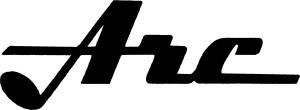
Arc Records
One record collector describes Arc records as follows:
Arc Records was Canada's most notorious low-budget label, in the same league as labels like Crown or Alshire in the States. They were famous for taking famous pop songs by one artist and getting some schmo to cover them and giving him a phoney name similar to that of the original artist. (Listener Klip at WMFU blog.)
A slightly more academic description of the label can be found on the Canadian Encyclopedia (page no longer active):
Arc Records, subsidiary of Arc Sound Co Ltd, which was established in Toronto in 1958 by Philip G. Anderson and William R. Gilliland. At first a record distributor, Arc Sound began releasing recordings under its own Arc label in 1959 and purchased the Precision Pressing Co in 1961. Arc Records released a series of pop singles albums under the name "Hit Parade" (1963-64). Arc Sound and its subsidiaries came under the control of a Canadian-owned holding company, the Ahed Music Corp Ltd, Toronto, in 1969 and ceased operations in 1986.
Arc Records in Canada were doing a lot of sound-alike records in the sixties. They had the Hit Parade series and at least two of them are carbon copies of Current Hits albums that appeared on the American Hit Records label.
Arc also apparently got tied in with Embassy Records (Great Britain), the label of the English Woolworth stores. It churned out top hits as well, usually with two different artists on one 45. All of the Embassy recording was done by Oriole Records, with mostly in-house musicians and groups. One of the cover bands on Embassy were The Jaybirds who became famous after Alvin Lee renamed the band to Ten Years After.
Embassy quit the sound-alike business in the late sixties and Oriole was bought by Columbia about the same time. Some of the Embassy/Oriole stuff showed up on American Top Hits albums from Columbia Record Club as well.
Arc Records had at least five LP's of Mersey Beat out in the mid sixties. Some of those list the individual Embassy performers, but most credit the group sounds to The Mersey Beats Of England. Unfortunately there is only a partial list of Arc releases available on the web. (Above text almost literally copied from KenB/Rockin' Bee.)

Three To One
In 1967 the Vancouver band Three To One issued a mono single considered to be the very first cover of a Pink Floyd song: See Emily Play / Give My Love (Arc 1186, most pictures and sound-bits on the web are from a 2008 collector's edition replica of that single, except - perhaps - the picture underneath that could be an original.)
Let's switch over to Kiloh Smith who describes this little gem in his weird enthusiast style...
Check out this rare Canadian psych 45 by Three To One - See Emily Play b/w Give Me Love on the Arc Label. This one’s got two monster tracks from Three To One, including what must to be the very 1st Pink Floyd cover in history. You might’ve heard their creepy cover of See Emily Play on a comp or two before - it’s pretty faithful to the original, at least up until the second chorus, when a little girl suddenly pops her head into the studio to ask “Everyone know how to play?” while someone in the sound effects library drops in a bunch of outer space phaser effects from the albino gorilla episode of the original Star Trek series.
This would have been an interesting titbit for all the Sydiots among us, but there is more going on. Arc was a rather dodgy label to say the least and also with this release they lived up to their expectancies.

See Emily Play was Three to One's only claim for fame. The Canadian Pop Encyclopedia describes them as follows:
Three To One
John Renton, Derek Norris (bass), Brian Russell (guitar), Claudette Skrypnyk
After leaving The Classics, Brian Russell formed Three To One in Vancouver in 1966. The band soon relocated to Yorkville in Toronto to try and catch a break. They soon got signed to Arc Records for one single - a cover of Pink Floyd's See Emily Play.
They also performed on CTV's 'After Four' TV show and appeared on Yorkville's tie-in compilation album to the show. They would later change their name to Raja before calling it quits.
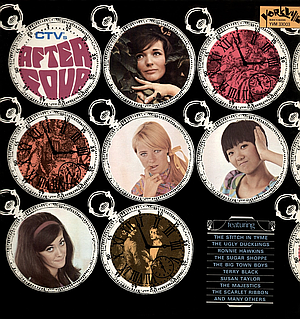
After Four
The After Four (dead link) TV-show compilation album was issued in 1968 on Yorkville, a sub-label of Arc. It has covers from well-known tracks such as You Keep Me Hangin’ On (Teak Wood, dead link) or Winchester Cathedral (The Chain Rattlers Orchestra). Several things are wrongly stated on its cover: Four In The Morning (dead link) from The Scarlet Ribbon is actually a track in disguise from a Canadian band called The Quiet Jungle (more about them later), Changin' Time (dead link) from Patrician-Anne is a cover from Janis Ian's I'll Give You a Stone If You'll Throw It (Changing Tymes) and the second track on the B-side is not I'm A Bad Boy by Bob Francis, but See Emily Play by Three To One. Nobody knows why there is a different track listed on the sleeve notes than there is pressed on vinyl. (Listen to the complete album on Grooveshark.)
So far so good, but here is where things get a bit more complicated. We did warn you.
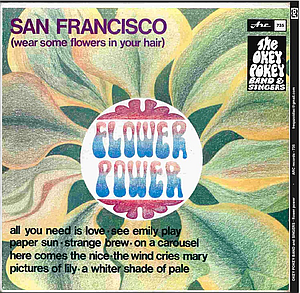
Flower Power
At about the same time, 1967-1968-ish, another Arc compilation album sees the light of day, featuring the Okey Pokey Band & Singers. The album with number A-735 is called Flower Power and has sound-alike versions of several 1967 hits, including See Emily Play. Here is what the liner notes have to say:
On this recording the zany, irrepressible Okey Pokey band & Singers focus on Flower Power. Resultant is a boss album highlighting the best sounds to blitz your transistor over the past months.
See Emily Play from Okey Pokey uses the same bed track (or background music, if you like) as the Three To One version but has different vocals. Some of the wacky sci-fi sound effects are missing, but the good thing is the track is in magnificent stereo hi-fidelity. The 'everyone know how to play' sample at 1:29 has mysteriously disappeared from this version as well.
In short: we have two versions of the same track, slightly remixed and with different vocalists, as if this had been recorded in a karaoke bar.
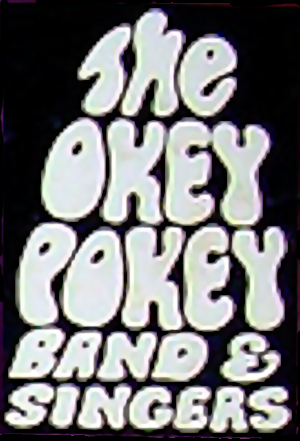
The Okey Pokey Band & Singers
The Okey Pokey Band & Singers released two full albums but were
obviously a studio project. According to the liner notes the band and
singers:
'have played San Francisco, capital of the hippy world',
'have
blown their minds at Fillmore' and
'loved-in at Ashbury Heights',
but
the credits show that the tracks were originally 'recorded in England'
and not in Canada.
This could make sense as we have already stated that low-budget record companies from different continents used to trade tracks, just to keep the costs low.
The Okey Pokey version has a certain British feel and when Arc got a copy of the master tape they may have removed the British vocals, replacing them with the Canadian singer of One To Three. Of course there is always the possibility that the English tape only contained an instrumental track and that both singing parts were recorded in Canada. A lot of sound-alike songs do exist that share the same bed track, but have different vocalists.
But Jenell Kesler (aka Streetmouse) at Discogs just thinks the record is entirely Canadian:
They also claim that these recordings where prestigiously done in England, when they were actually done in Canada on a low budget. There is speculation that the ‘original’ instrumental tracks, the bedrock tracks for these songs where purchased or lifted, with additional effects and vocals being laid down on top of them to give the feel of the real thing … though why [?]...
The Quiet Jungle
In 2007 Garage Hangover suspected that members of The Quiet Jungle could have been part of the deal.
Toronto based The Quiet Jungle started originally as The Secrets. The band was signed by Arc Records and, next to releases in their own name, some of them hit records, they were used as (anonymous) session musicians on a Monkees sound-alike album and on a children's album called The Story of Snoopy's Christmas. Vocalist Doug Rankine, however, denies any involvement on the Okey Pokey Flower Power album:
We had nothing to do with the "Flower Power" album. There were a couple of TV shows at that time called After Four and High Time that were on CTV. We were on those shows verily often. There was an album produced at the time called "After Four". (…) At the time of the album we recorded a song entitled "Four In the Morning". Without going into a lot of detail, we recorded it under the name of the Scarlet Ribbon.

John Smith
Anton from Freqazoidiac adheres the theory that the Okey Pokey version, including its vocals, is entirely British.
The missing link could be John Smith, who - as John Smith and the New Sound - had several big hits, notably in France and Germany, with Manchester Cathedral, Snoopy vs the Red Baron, Just A Looser and Judy In Disguise.
It has been rumoured that Manchester Cathedral by The Chain Rattlers Orchestra (see the After Four album above) was in fact done by John Smith. You Keep Me Hangin' On from Teak Wood on that same compilation is definitely John Smith's work. He has acknowledged this himself on Garage Hangover.
The only problem is that John Smith (that is his real name, by the way) denies having ever recorded See Emily Play:
In answer to your first question "See Emily Play", I didn't record that song. If my name and my band was used, this is new to me, but I don't think there's much I can do about that is there!
The real John Smith left after the first album but the band continued to record, with different lead-singers as John Smith and the New Sound. None of their three official albums (and singles) have See Emily Play. John Smith and the New Sound (and their alter-ego band The Beat Kings) took a joyride on the wave of British and Canadian pop, but they can't be linked to the Okey Pokey / Three To One See Emily Play versions. This means we are back to square one.

Ben Cash & The Cash-Tons
Probably the John Smith rumour can be traced back to a typo on, where else?, the Internet. In a comment on the Red Telephone 66 (dead link) blog Jancy claims that John Smith and The New Sound recorded See Emily Play for a German compilation (that appeared in 1972).
However, on the record itself, England's Top 14 of Pop (20. Folge) (private link) from Deutsche Vogue, See Emily Play is credited to Ben Cash & The Cash-Tons, and not to John Smith, nor The Beat Kings.
And yes, might you wonder, this third 'German' cover version is exactly the same as the Okey Pokey one. It could be interesting to compare the Ben Cash & The Cash-Tons cover from My Generation with the Arc release (if any) but this would bring us too far in this messy labyrinth.
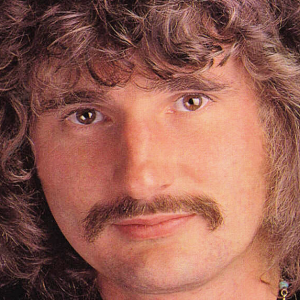
David Byron
There is an unconfirmed rumour that Ben Cash was none other than David Byron (real name: David Garrick) from Uriah Heep fame. The (more than excellent) David Byron fansite claims that the singer could be present on at least 140 low-budget covers on Avenue Records. They have - so far - identified (and re-issued) 40 tracks sung by Byron, but they don't include See Emily Play on this list.
Multiple versions were recorded of many of the Avenue tracks and sometimes included as many as five different lead vocalists. These tracks were released on various vinyl records under titles such as Top Six, Top Six From England, 12 Top Hits, England’s Top 12 Hits, Chartbusters, Studio 33; and compilations such as Groovin’, The Rock Star Parade, Super Soul Sounds and multiple other titles. David participated on multiple releases under these names but its apparent some of the releases listed false artist names but not the actual participants. David sang under listings such as Dave’s Soul Group, The Beat Kings and the rehashed name John Smith and The New Sound. Multiple other names are known and they overlap by other artists as well but again this can't be listed with accurate results. (Taken from Travellers In Time.)
Update 21 07 2012: Ron Mann from David Byron Net confirmed us that: "David Byron wasn’t part of that [See Emily Play] session", but he doesn't know who the singer is. He was so kind to lead us to some people who do know a lot more about these low budget sessions, so fingers crossed and keep on checking the Church. (February 2012: it needs to be said that we didn't find new information about this release, but we still keep on searching.)
Amongst the other lead singers that have participated on the hundreds of Avenue sound-alike recordings are: Reginald Dwight who was a bit more successful later in his career as Elton John, Tony Steven, Peter Lee Stirling (aka Daniel Boone) and Danny Street.

John Smith (reprise)
The David Byron website continues with the following information.
At one point there was a real John Smith and a real New Sound backing band. In the 60s he signed a solo deal with Parlophone and released singles under the name of Bobby Dean. Being managed by Bill Wellings he ended up at EMI's Top Six label doing discount records cover songs.
These recordings were released in the UK and Germany and had some success. The Vogue record label released these songs under the original band name but also as The Four Kings. By late 1967 John Smith himself had lost interest in the group and moved on.
This left Bill Wellings with a band but no lead-singer but nevertheless he decided to continue the band, without the consent or knowledge of the real John Smith. As Wellings was deep in the discount records business and was interchanging vocalists with Avenue Records at PYE Studios in London he had several people to choose from.
Several tracks were done by the lead vocalist of The Excheckers, Phil Blackman, but also David Byron did vocals on some tracks for the two John Smith and the New Sound albums that followed.

The Golden Ring
But the confusion isn't over yet, because the See
Emily Play cover will appear once again under another name. So far
we are aware of four releases of this cover:
1. Three To One
(1967, Canadian single)
2. Three To One (1968, Canadian album,
same as 1)
3. Okey Pokey Band & Singers (1968, Canadian album,
same backing track, but other vocalist)
4. Ben Cash & The
Cash-Tons (1972, German album, same as 3)
All these versions take about 2 minutes and 50 seconds, but Cicodelico came across a version on an Arc EP that is about a minute shorter: See Emily Play. The EP in question (TS 10) has All You Need Is Love, See Emily Play and With A Little Help From My Friends and is recorded by The Golden Ring. It is just a shortened version of the Okey Pokey original and probably this was done to fit on the seven-inch record with the other songs.
The Golden Ring are another one of these tribute bands on Arc who issued at least 22 albums, EPs and singles: A Man Without Love, A Tribute To Johnny Cash, Love Me Tonight, The Little Drummer Boy, Tribute To Glen Campbell and many others...
Epilogue
If the original See Emily Play sound-alike has been recorded in England, with or without vocals, then the (Canadian) Three To One version is not the first cover of a Pink Floyd song. Unfortunately, we don't know where, when and by who this took place. Okey Pokey, The Golden Ring and The Cash-Tons are all fictitious bands that never existed as such. Three To One, however, did exist as a band and they were probably glad to add their voices to an already existing bed track, coming from the UK. It is pretty weird that nobody has located a British release, but perhaps the Pink Floyd and Syd Barrett were already considered too weird to fit in the low-budget marketing scheme.
(We have another article mentioning sound-alike records and artists, regarding the lost Pink Floyd Early Morning Henry session that apparently was a William Butler cover: Singing A Song In The Morning.)
Links & Stuff
We apologise for this post that is probably the most confusing ever at the Holy Church of Iggy the Inuit. We have tried contacting a few people and as such there may still be updates to be published. And if someone of you happen to know who really recorded the (probably English) low-budget-version of See Emily Play, let us know!
See Emily Play flowchart
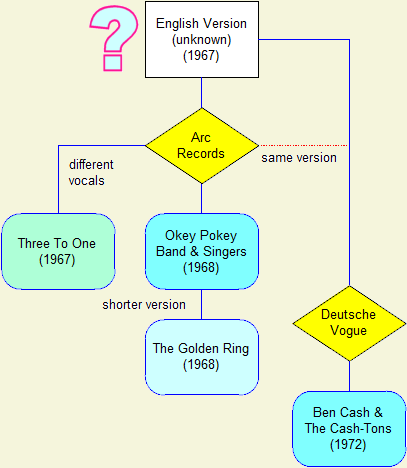
See Emily Play versions @ YouTube

Three To One single version (1967, 2008 re-issue)
http://www.youtube.com/watch?v=LpSfgRxz704
(The
1967 version was also re-issued on Pebbles, Volume
14 in 1984.)
Three To One - Give me Love (flip-side)
http://www.youtube.com/watch?v=AS8vo34UamU
CTV’s After Four - album version (1968)
http://www.youtube.com/watch?v=Gq0pKQzaU94
The Okey Pokey Band & Singers - Flower Power (album version,
1968)
http://www.youtube.com/watch?v=U4M_qBw2q40
The Golden Ring - All You Need Is Love (EP version, 1968)
http://www.youtube.com/watch?v=jJYgzSbb1rw
Ben Cash And The Cash Tones - England's Top 14 of Pop (20. Folge)
(album, 1972)
http://www.youtube.com/watch?v=YlKubn-hTqs

CTV’s After Four - album (1968)
http://freqazoidiac.blogspot.be/2007/06/ctv-after-four-1967-canada-yorkville.html
John Smith & The New Sound
http://www.myspace.com/johnsmithsound
http://www.garagehangover.com/?q=johnsmith
http://badcatrecords.com/BadCat/SMITHjohn.htm
The Quiet Jungle
http://www.garagehangover.com/?q=QuietJungle
Updated version, July 2017, some rewriting, weeding of dead links,
updating of pictures. Many thanks to: Anton (Freqazoidiac), Cicodelico,
Greeneyedbetsy, Jancy, KenB / Rockin' Bee, Kiloh Smith, Listener Klip,
Ron Mann, Streetmouse (Jenell Kesler)...
♥ Iggy ♥ Libby ♥